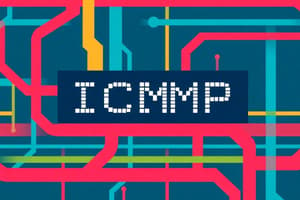Podcast
Questions and Answers
Flow control determines how fast data can be transmitted and how much information can be delivered.
Flow control determines how fast data can be transmitted and how much information can be delivered.
True (A)
Unicast communication refers to one-to-many communication.
Unicast communication refers to one-to-many communication.
False (B)
Broadcast communication sends a message to all devices on the network in both IPv4 and IPv6 networks.
Broadcast communication sends a message to all devices on the network in both IPv4 and IPv6 networks.
False (B)
Message timing is not crucial in network communications.
Message timing is not crucial in network communications.
Access method determines when more than one device can send messages at the same time without any issues.
Access method determines when more than one device can send messages at the same time without any issues.
In networking, protocols are the rules that communications will follow.
In networking, protocols are the rules that communications will follow.
Message destination in communication refers to the sender of the message.
Message destination in communication refers to the sender of the message.
Channel in communication consists of the media that provide the pathway over which the message travels from source to destination.
Channel in communication consists of the media that provide the pathway over which the message travels from source to destination.
All network protocols have the same requirements for delivery, including common language and grammar.
All network protocols have the same requirements for delivery, including common language and grammar.
Network protocols govern aspects like flow control, message timing, access method, unicast, and broadcast communication.
Network protocols govern aspects like flow control, message timing, access method, unicast, and broadcast communication.
Encapsulation is the process where protocols add their information to the data.
Encapsulation is the process where protocols add their information to the data.
Multiplexing involves taking multiple streams of segmented data and separating them.
Multiplexing involves taking multiple streams of segmented data and separating them.
Segmenting messages can lead to increased speed in data transmission.
Segmenting messages can lead to increased speed in data transmission.
De-encapsulation happens as data moves down the stack.
De-encapsulation happens as data moves down the stack.
TCP is responsible for sequencing the individual bits in the data stream.
TCP is responsible for sequencing the individual bits in the data stream.
Message encoding is the process of converting information into an unacceptable form for transmission.
Message encoding is the process of converting information into an unacceptable form for transmission.
Message formatting involves placing one message format inside another message format, known as encapsulation.
Message formatting involves placing one message format inside another message format, known as encapsulation.
IP is responsible for sending a message from the message source to multiple destinations over a network.
IP is responsible for sending a message from the message source to multiple destinations over a network.
In a network, there are no size restrictions on frames when it comes to message size.
In a network, there are no size restrictions on frames when it comes to message size.
Message timing refers to the process of determining when to initiate the communication between the sender and receiver.
Message timing refers to the process of determining when to initiate the communication between the sender and receiver.
Flashcards are hidden until you start studying




